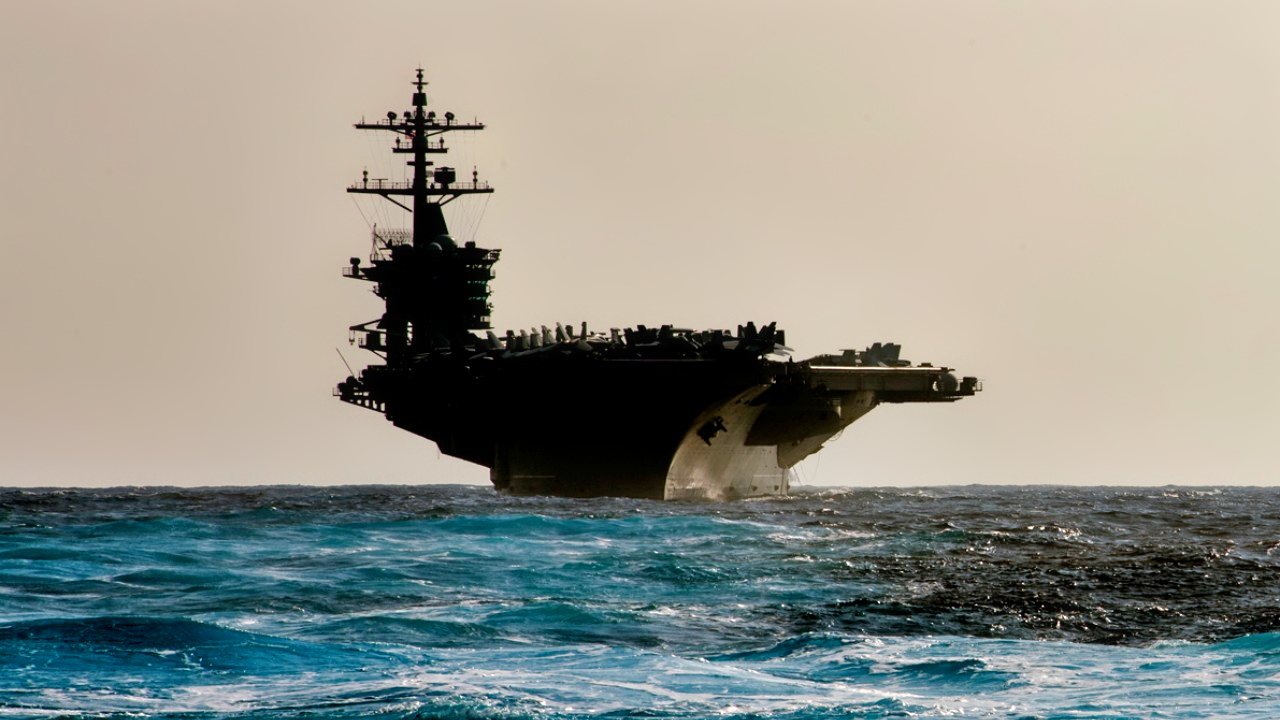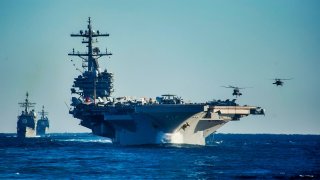A2/AD: How China Plans to Destroy the U.S. Navy's Aircraft Carriers
At its core, A2/AD is a grouping of “sensors; antiship, antiaircraft, and ground defenses; and long-range fires utilized by U.S. competitors and designed to prevent the United States from entering into a closed fight.”
About a decade ago, when I got to Washington, D.C., and assumed my position as a taxpayer-funded bureaucrat, “A2/AD” was all anyone could talk about in Congressional briefings, at bars, or at think tank symposia. As a young man of little means, I often nodded along dutifully when my superiors would bring it up in conversation.
What was it, I often wondered? Was it some new government agency?
None of the above, as it turned out.
Understanding A2/AD
We talk about A2/AD quite a bit. But rarely is a definitive, readable explanation given. Most analysts have strong opinions about the state of “anti-access/area denial,” or, A2/AD. It’s important to understand why they have such strong opinions. Because, at its core, A2/AD capabilities could determine whether US military power can be projected reliably into a contested area, such as the South or East China Seas or the Taiwan Strait.
Fears of A2/AD are stymying the full power projection of the United States Navy into regions like the Red Sea or the Strait of Bab El-Mandeb, where the Yemen-based Houthi Rebels are terrorizing civilian shipping in those two waterways on behalf of their Iranian benefactors.
The US Navy has struck back, but it took some period of thought to mitigate any A2/AD threat to the safety of the US Navy aircraft carrier operating in the region, the USS Eisenhower. That’s because, thanks to their relationship with Iran (and Iran’s relationship with Russia and China, two A2/AD superpowers), the Houthis gained access to an increasingly complex arsenal of A2/AD weapons.
So, now, the pitiful Houthi Rebels are even able to complicate the safe operations of modern warships, like US aircraft carriers.
Anti-Access/Area Denial Defined
At its core, A2/AD is a grouping of “sensors; antiship, antiaircraft, and ground defenses; and long-range fires utilized by U.S. competitors and designed to prevent the United States from entering into a closed fight.”
Readers often hear analysts refer to “A2/AD bubbles” or just “bubbles.”
That’s because the presence of a fully integrated arsenal of A2/AD systems allows for a defender, such as China, to create what most US war planners fear is an impenetrable shield—or a bubble—around a contested territory. This A2/AD bubble would prevent most US weapons platforms from getting in close enough to attack, in this example, Chinese forces.
And, you guessed it, that means keeping powerful U.S. Navy aircraft carriers far away enough that they can't use their powerful air wings to attack--or risk being sunk by overwhelming force.
By keeping US forces at a distance, Chinese strategists believe they would have the opportunity to overwhelm their local enemies, whether it be Japan over the Senkaku islands, the Philippines, or Taiwan.
According to defense expert Harry Kazianis, Chinese A2/AD systems use “a combination of various military platforms such as ultra-quiet submarines, over 80,000 sea mines, various types of cyber warfare, anti-satellite weapons and swarm attacks by ballistic and cruise missiles.”
One should add China’s rapidly advancing hypersonic weapons systems as well as their unmanned underwater vehicle (UUV) and unmanned aerial vehicle (UAV) fleets to this toxic admixture that could prove fatal to the US sailors, airmen, and marines who would be on the frontlines of any US military response (the Army would be involved as well, but increasingly, the Navy, Air Force, and Marines are planning to take the brunt of the burden in any potential fight with China).
The Who’s-Who of A2/AD
The Russian Federation, Islamic Republic of Iran, and Democratic People’s Republic of Korea (North Korea), all have a complex arsenal of variegated A2/AD systems.
Other potential US rivals, such as Venezuela, are rapidly developing their own A2/AD arsenal with the keen understanding that these relatively cheap and simple systems could be the key to stunting US military power projection. In fact, in the last year, Venezuela has apparently purchased a small group of Iranian Peykaap-III missile boats which “can carry up to two anti-ship missiles of the Kowsar-type (with a launch range of up to 20 km and a warhead weight of 29 kg) or Nasr-1 (with a range of up to 35 km and a warhead weight of 150 kg).”
Venezuela’s A2/AD capability is rudimentary compared to the vast, growing, and complex A2/AD systems of its Chinese, Russian, and even Iranian allies. But the fact that Caracas desires to take the massive oil fields of neighboring Guyana, and that they are backed heavily by China, Russia, and Iran, means that Venezuela’s relatively basic A2/AD arsenal might rapidly evolve into a very real threat.
Caracas could threaten the power projection capabilities of their neighbors (like Brazil), as well as the US military over time.
Recently, the US Navy deployed the aircraft carrier USS George Washington as a sign of deterrence against Venezuela’s growing threat to Guyana. At some point, though, even tiny Venezuela might build the A2/AD capacity needed to keep American systems over-the-horizon. And this is the real threat that A2/AD poses to the US military, which is inherently an expeditionary, all-volunteer (therefore, relatively small) force that depends upon advanced, expensive technologies and platforms to serve as force multipliers.
Should those force multipliers be degraded or even be made obsolete by sophisticated A2/AD, that’s when the US military risks losing a war.
Where Do We Go From Here?
It’s a fairly bleak outlook that the US military finds for itself in the major contested areas of the globe. But there is hope. Almost immediately after the Chinese A2/AD threat became apparent in the 2010s, Washington started formulating its strategic response to this threat. While their preferred plan, in my opinion, is flawed, at least Washington is thinking about overcoming this threat.
Currently, Washington aims to deploy the Air Force, Navy, and Marines in what it calls the “AirSea Battle” concept. This strategy is designed to use primarily the three aforementioned US military branches, along with any allies, “burst” the A2/AD bubbles a rival establishes. It is a forward-deployed, offensive strategy.
Another strategy that was put forward by the likes of T.X. Hammes and, later, Mackubin Owens, calls for basically deploying the US Navy to blockade China at a distance. This has been called “Offshore Control.” Since China relies heavily on maritime-based trading routes to bring key resources to their economy, such as oil from the Middle East, the Navy would blockade key trading chokepoints to stop the flow of goods from abroad into China during a conflict.
This strategy, by the way, was one reason behind China’s bid to create the Belt-and-Road (BRI), a network of Beijing-dominated trading routes across Eurasian land routes as well as maritime routes hugging close to Eurasia’s shores, where China assessed the US Navy would be harder-pressed to interdict and disrupt. Thus far, however, China’s desperate bid to create the BRI has led to mixed results for China, at best.

Still, Beijing has telegraphed, frankly, what their doomsday scenario is.
It is not the Pentagon's costly and irresponsible AirSea Battle concept that Beijing fears (likely because it plays into China’s inherent military and geographical advantages). Beijing fears the Offshore Control policy as a way to overcome China’s A2/AD systems.
What’s more, an Offshore Control strategy coupled with the Air Force and Navy’s (as well as the Army’s and Marine’s) increasing long-range penetration capabilities might be far better for “bursting” China’s A2/AD “bubbles.”
Of course, under international law, a blockade is an act of war. Nevertheless, war is coming between the United States and China. The Americans need to be prepared. Under present conditions, they are not. And China knows this. Sadly, given how close both Russia and China have become, along with Iran and North Korea--all of which could transport goods to China overland--it remains to be seen how effective even the preferred strategy of Offshore Control could be.
About the Author
Brandon J. Weichert, a National Interest national security analyst, is a former Congressional staffer and geopolitical analyst who is a contributor at The Washington Times, the Asia Times, and The-Pipeline. He is the author of Winning Space: How America Remains a Superpower, Biohacked: China’s Race to Control Life, and The Shadow War: Iran’s Quest for Supremacy. His next book, A Disaster of Our Own Making: How the West Lost Ukraine, is due October 22 from Encounter Books. Weichert can be followed via Twitter @WeTheBrandon.


